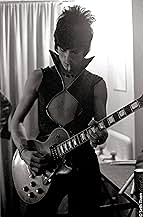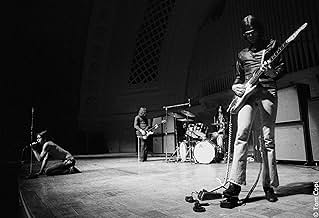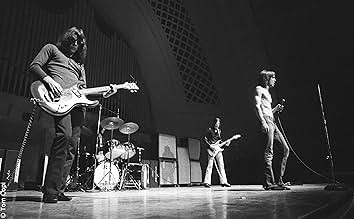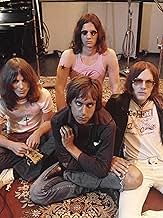IMDb RATING
7.2/10
6.7K
YOUR RATING
An in-depth look at legendary punk band The Stooges.An in-depth look at legendary punk band The Stooges.An in-depth look at legendary punk band The Stooges.
- Awards
- 1 win & 4 nominations total
Jim Jarmusch
- Self
- (voice)
Bob Waller
- Self
- (archive footage)
The Stooges
- Themselves
- (archive footage)
Ron Asheton
- Self
- (archive footage)
Harry Partch
- Self
- (archive footage)
MC5
- Themselves
- (archive footage)
John Sinclair
- Self
- (archive footage)
David Bowie
- Self
- (archive footage)
The Damned
- Themselves
- (archive footage)
Sonic Youth
- Themselves
- (archive footage)
- Director
- Writer
- All cast & crew
- Production, box office & more at IMDbPro
Storyline
Did you know
- TriviaIggy Pop also plays himself in another Jim Jarmusch movie, Coffee and Cigarettes. And also Dead Man (1995).
- ConnectionsFeatures Dante's Inferno (1911)
- SoundtracksAsthma Attack
Written by Iggy Pop (James Osterberg Jr.), Ron Asheton (as Ronald Asheton), Scott Asheton, David Alexander
Performed by The Stooges
Courtesy of Elektra Entertainment Group
By arrangement with Warner Music Group Film & TV Licensing
Featured review
This plodding, by-the-numbers doc manages to make the Stooges (of all bands) seem boring. I know a LOT about the band and their music, and I found this film to be stiff and fairly dull; I can't imagine anyone unfamiliar with the Stooges sticking it out.
The first big problem is that Jarmusch proceeds with the assumption that the viewer reveres the Stooges as much as he does. The film doesn't really bother to make an argument for their greatness, or even discuss the specifics their music much, beyond the making of the first album. Instead, it focuses on superficial details like what city they were in at any given time; light music-biz gossip, etc. It's almost absurd how little is said about the aesthetics of "Fun House" and "Raw Power."
Usually, docs like this will have other rock luminaries and music critics talking about how the subject artist inspired them personally, made a mark on rock history, etc. That approach is absent here. Mike Watt is interviewed at length, but only to go over the minute details of how the band reunited in the 2000s. Much is said about how J. Mascis was instrumental in pulling the guys back together -- why is he not on camera, talking about what their music meant to him? (Danny Fields also shows up, to recount some stories told at greater length in the "Please Kill Me" book... this is cool, as far as it goes.)
Instead of making a case for the Stooges' place in the pantheon, Jarmusch just plays a montage of "punk" album covers (y'know, because the Stooges "inspired punk"), followed by clips of younger bands covering their songs. It makes the Stooges seem like a smaller and much less consequential band than they were... you come away with the impression of a minor act that recorded a few songs people like.
Another strange choice is to begin the doc at a "turning point" in the band's career, then go back to the beginning and tell the story up to that point (and beyond it). This is a very common approach in documentaries and biographies... but in this case, the "turning point" is the band's dissolution in the early '70s (after "Fun House"). The film begins by presenting a drugged-out, worn-out, falling-apart group of guys, and then expects the viewer to care how they got to that (not very interesting or unique) point(?) Once the chronological story line does kick in, it proceeds without tension or suspense. Jarmusch compensates for a lack of extensive archival footage by frequently throwing in old film clips, apparently in an attempt to "humorously" illustrate what interviewees are saying... I found this move to feel obvious and "smug."
A final problem is the extent to which Jarmusch relies on recent interviews conducted with Iggy. He seems to have simply turned on the camera and let Iggy drone on, and then included big chunks of the footage in the doc. Let's just say that it does not do the film, or Iggy himself, any favors.
I can't remember ever before watching a documentary about a respected band or artist, and coming away less of a fan than I was going in... but somehow, "Gimme Danger" managed to achieve that.
The first big problem is that Jarmusch proceeds with the assumption that the viewer reveres the Stooges as much as he does. The film doesn't really bother to make an argument for their greatness, or even discuss the specifics their music much, beyond the making of the first album. Instead, it focuses on superficial details like what city they were in at any given time; light music-biz gossip, etc. It's almost absurd how little is said about the aesthetics of "Fun House" and "Raw Power."
Usually, docs like this will have other rock luminaries and music critics talking about how the subject artist inspired them personally, made a mark on rock history, etc. That approach is absent here. Mike Watt is interviewed at length, but only to go over the minute details of how the band reunited in the 2000s. Much is said about how J. Mascis was instrumental in pulling the guys back together -- why is he not on camera, talking about what their music meant to him? (Danny Fields also shows up, to recount some stories told at greater length in the "Please Kill Me" book... this is cool, as far as it goes.)
Instead of making a case for the Stooges' place in the pantheon, Jarmusch just plays a montage of "punk" album covers (y'know, because the Stooges "inspired punk"), followed by clips of younger bands covering their songs. It makes the Stooges seem like a smaller and much less consequential band than they were... you come away with the impression of a minor act that recorded a few songs people like.
Another strange choice is to begin the doc at a "turning point" in the band's career, then go back to the beginning and tell the story up to that point (and beyond it). This is a very common approach in documentaries and biographies... but in this case, the "turning point" is the band's dissolution in the early '70s (after "Fun House"). The film begins by presenting a drugged-out, worn-out, falling-apart group of guys, and then expects the viewer to care how they got to that (not very interesting or unique) point(?) Once the chronological story line does kick in, it proceeds without tension or suspense. Jarmusch compensates for a lack of extensive archival footage by frequently throwing in old film clips, apparently in an attempt to "humorously" illustrate what interviewees are saying... I found this move to feel obvious and "smug."
A final problem is the extent to which Jarmusch relies on recent interviews conducted with Iggy. He seems to have simply turned on the camera and let Iggy drone on, and then included big chunks of the footage in the doc. Let's just say that it does not do the film, or Iggy himself, any favors.
I can't remember ever before watching a documentary about a respected band or artist, and coming away less of a fan than I was going in... but somehow, "Gimme Danger" managed to achieve that.
- How long is Gimme Danger?Powered by Alexa
Details
- Release date
- Country of origin
- Official sites
- Language
- Also known as
- Gimme Danger: La historia de the Stooges
- Production companies
- See more company credits at IMDbPro
Box office
- Gross US & Canada
- $440,627
- Opening weekend US & Canada
- $44,725
- Oct 30, 2016
- Gross worldwide
- $950,040
- Runtime1 hour 48 minutes
- Color
- Aspect ratio
- 1.78 : 1
Contribute to this page
Suggest an edit or add missing content





































